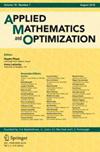凸期望下随机极大值原理与动态规划原理的关系
IF 1.7
2区 数学
Q2 MATHEMATICS, APPLIED
引用次数: 0
摘要
本文研究了以G -期望为主导的一致凸期望下前-后向控制系统的极大值原理(MP)与动态规划原理(DPP)的关系。在对值函数的光滑假设下,通过建立一个有用的估计,得到了参考概率下的MP和DPP之间的关系。如果值函数不光滑,则在任意t处,我们得到值函数的一阶子射流和超射流。但是,这种情况下的处理方法要比t = 0时的处理方法困难得多。本文章由计算机程序翻译,如有差异,请以英文原文为准。
Relationship Between Stochastic Maximum Principle and Dynamic Programming Principle Under Convex Expectation
In this paper, we study the relationship between maximum principle (MP) and dynamic programming principle (DPP) for forward–backward control system under consistent convex expectation dominated by G -expectation. Under the smooth assumptions for the value function, we get the relationship between MP and DPP under a reference probability by establishing a useful estimate. If the value function is not smooth, then we obtain the first-order sub-jet and super-jet of the value function at any t. However, the processing method in this case is much more difficult than that when t equals 0.
求助全文
通过发布文献求助,成功后即可免费获取论文全文。
去求助
来源期刊
CiteScore
3.30
自引率
5.60%
发文量
103
审稿时长
>12 weeks
期刊介绍:
The Applied Mathematics and Optimization Journal covers a broad range of mathematical methods in particular those that bridge with optimization and have some connection with applications. Core topics include calculus of variations, partial differential equations, stochastic control, optimization of deterministic or stochastic systems in discrete or continuous time, homogenization, control theory, mean field games, dynamic games and optimal transport. Algorithmic, data analytic, machine learning and numerical methods which support the modeling and analysis of optimization problems are encouraged. Of great interest are papers which show some novel idea in either the theory or model which include some connection with potential applications in science and engineering.

 求助内容:
求助内容: 应助结果提醒方式:
应助结果提醒方式:


